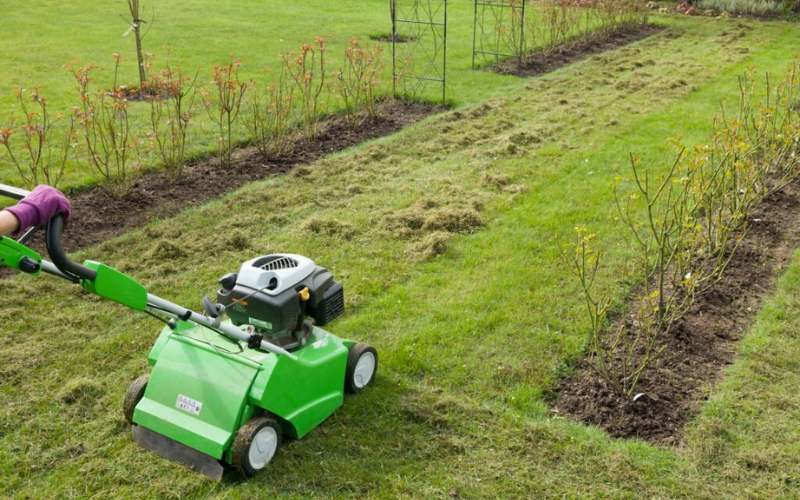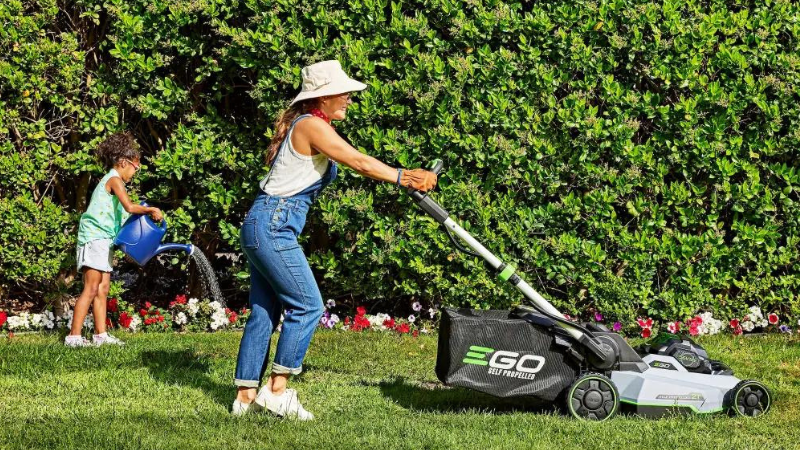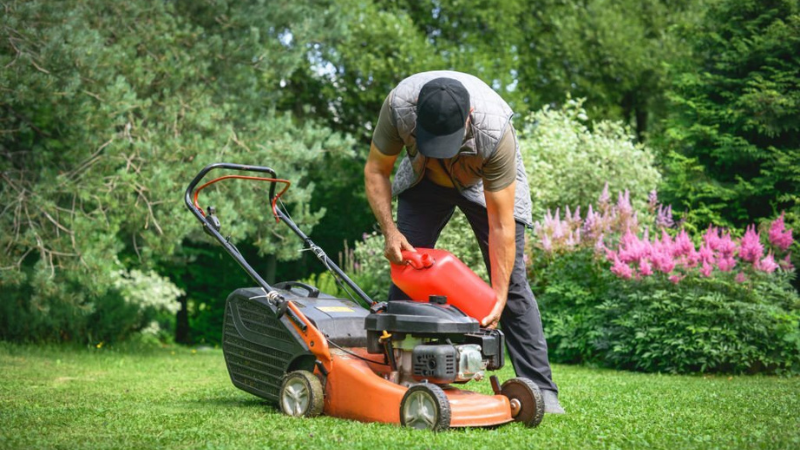A lawn thatch is a dense mat of dead grass, clippings, and dead insect matter accumulating on the lawn over time. Scarifying removes the thatch on lawn surfaces and ensures water, vital nutrients, and oxygen flow. It also encourages the growth of a healthier and thicker turf.
We evaluated the best scarifiers in Australia and compiled our top picks to help you find the one that suits your lawn and garden needs. We include mechanical, gas-powered, battery-powered, and corded-electric scarifiers, many of which double lawn aerators and dethatchers.
Our Top Picks
Here is a quick roundup of our top three lawn scarifiers on the Australian market:

Makita UV001GZ Scarifier
Best cordless lawn scarifier with a 38 cm cutting width, adjustable depth from +5mm to -12mm in 1mm steps, and a 50-litre collection bag.

Greenworks 40V Scarifier
Best battery-powered lawn scarifier with a cutting width of 36 cm, five cutting height steps, and a 45-litre collection bag.

Hyundai HYSC210 Scarifier
Best petrol lawn scarifier with a 4-Stroke OHV Single Valve engine, 40 cm cutting width, 45 L collection bag, and a stepless cutting depth.
Top 7 Lawn Scarifiers for Australians
Our in-depth analysis and evaluation of the lawn scarifiers below consider each scarifier's use cases, product features, user experience, and feedback. The following is a complete assessment of our top picks.
1. Makita UV001GZ Scarifier
Best Overall Lawn Scarifier

Cutting width: 38 cm
Cutting height: 18 steps
Collection bag: 50 litres
The Makita UV001GZ is a high-performance cordless scarifier ideal for Australian lawns. It features a 1.7kW brushless motor delivering up to 3,200rpm, making it perfect for dethatching and vertical cutting. The 38cm cutting width and adjustable working depth from +5mm to -12mm (with 1mm increments) ensure precise and efficient lawn care.
This scarifier has a 50-litre collection container for hassle-free operation. Its robust design includes large 180mm front and rear tires, rear discharge, and a foldable, height-adjustable handle for easy storage. You also get advanced features like automatic battery switching (for two batteries, not included), a lock-off function, and an electric brake for safety.
The scarifier's battery is part of Makita’s 40V XGT system, ensuring powerful performance and fast charging. Combined with its durable, water-resistant cutting deck, constant speed control, and 1-year warranty, the UV001GZ is built for tough grass and easy moss removal.
Pros
- Precise depth adjustment
- Robust motor with speed control
- Large wheels for stability
- Easy to operate
Cons
- Noisy during operation
- Slight vibrating in operation
- Skin only
2. Greenworks 40V Dethatcher & Scarifier
Best Battery-Powered Lawn Scarifier

Cutting width: 36 cm
Cutting height: 5 steps
Collection bag: 45 litres
The Greenworks dethatcher tool is a battery-powered scarifier; you can start scarifying instantly, free, and without cables. The scarifier features rechargeable 40V batteries that do not come with the product. You must purchase them separately or use batteries from other Greenworks products since they are compatible.
The scarifier tool has two cylinders that aerate and scarify to ensure a beautiful and healthy lawn. It ensures new growth for the lawn with the assistance of the 36 cm wide aerator for removing leaves, dead moss, and grass, thereby ensuring good absorption of light, water, and nutrients. The tool has a speed of 3900 rpm and a central working height, which homeowners can adjust in five steps between -12 mm and +5 mm.
Greenwork's dethatcher also features twenty steel blades that scarify the soil, operating deeply and vertically to improve oxygenation, nutrient uptake, and drainage. Its four wheels offer safe support and excellent manoeuvrability even on irregular terrains during use.
Pros
- Portable and manoeuvrable
- 5 levels of adjustment
- Easy to switch the dethatching and scarifying
- Brushless motor for low noise
- Large collection bag
Cons
- Battery is not included
3. Hyundai HYSC210 Scarifier & Aerator
Best Petrol Lawn Scarifier

Engine: 4-Stroke OHV Single Valve
Cutting width: 40 cm
Collection bag: 45 L
The Hyundai HYSC210 is a petrol-powered machine with a 4-stroke OHV petrol engine that delivers superior scarifying and aerating performance. It offers better fuel efficiency and less pollution as it consumes fuel once every four strokes. Still, it doesn't compare to electric and battery-powered models, which have zero emissions.
On the brighter side, you don't need extra oil to operate the engine. Only lubrication is necessary for the moving parts. The cylinder on the Hyundai HYSC210 has eighteen hardened steel blades. So, you can expect it to penetrate the toughest soils and thatches easily. Likewise, its stepless cutting depth is easily adjusted from -1.5 to +1.5 cm for work on different lawns and yard conditions.
For ease of use and ergonomics, Hyundai’s HYSC210 handle is ergonomically designed, and the controls are conveniently positioned on the right side of the handle for easy operation. The convenient transport position also makes movement over paving and decking easier.
Pros
- Large catcher bag
- Freedom of movement without power cords
- Powerful 4-stroke engine for large lawns
- Deeper penetration for tough thatches and weeds
- Easy to use and operate
Cons
- Heavy tool
- Petrol engine is noisy
4. Sun Joe AJ801E Electric Scarifier
Best Scarifier for Small Yards

Cutting width: 32 cm
Cutting height: 5 positions
Collection bag: 30 litres
The Sun Joe lawn scarifier is perfect for revitalising mid to small-sized lawns. The tool is powered by a robust 12amp motor and a 32 cm cutting path to get the job done in a single move. It has Air boost technology that maximizes thatch pickup and spring steel tines, which stay sharp longer enough to ensure reliable performance.
Sun Joe's lawn scarifier features a 5-position depth control knob to tailor the raking depth from 10mm below the earth to 10mm above the soil, depending on the lawn's scarifying/aerating needs. The model also has a 30-litre thatch collection bag to ensure easy disposal.
Being an electric scarifier, you can start the device instantly by pushing a button. Similarly, it comes with a safety switch that prevents accidental starting. On the downside, it's corded, which limits movement during operation. It weighs 12.25 kg and is built with alloy steel for enhanced durability.
Pros:
- Efficient 32cm cutting path
- Air Boost for thatch pickup
- Durable spring steel tines
- Instant start with safety switch
- Sturdy alloy steel construction
Cons:
- Corded limitation
- Average 30L collection bag
5. Ryobi 2x18V ONE+ Brushless Scarifier
Best Scarifier With Large Collection Bag

Cutting width: 35 cm
Cutting height: 4 positions
Collection bag: 55 litres
The Ryobi 2x18V ONE+ Brushless Scarifier helps remove debris that can be devastating, leaving your lawn looking dull and soggy. Its 16 stainless steel blades help reduce the layers of thatch in the lawn, which prevents water and fertiliser from penetrating the roots of the grass.
The lawn scarifier is also tough enough to deal with challenging soil types. It features a 35cm-wide scarifying path and four depth settings to help achieve your dream lawn without all the effort of raking or the expense of bigger machines.
To drive the Ryobi ONE+ brushless scarifier powerful and get maximum results from the device, you will need 2 X 18V ONE+ batteries. This unit comes with foldable/collapsible handles that are easy to store. It also includes a 55-litre debris catcher (the largest on our list) that collects dead grass, debris, and thatch, removing the need to rake up after use manually.
Pros
- Effective debris removal
- 35 cm-wide scarifying path
- Powerful brushless operation
- Foldable/collapsible handles for storage
- 55-litre debris catcher
Cons
- Battery purchase required
6. Costway Rolling Scarifier
Best Manual Lawn Scarifier

Height: 21 cm
Width: 45 cm
Weight: 3.5 kg
The Costway Rolling Scarifier is our top pick for a manual lawn scarifying tool in Australia. It’s easy to use and a resourceful way to keep your yard scarified and healthy. Note that being a manual scarifier, it lacks the advanced features of powered scarifier models.
The rolling scarifier is made of robust quality materials. Its PP plastic wheels are durable and easy to control, reducing the effort you need to scarify thick thatches. Likewise, the galvanised steel pipe and heavy-duty nails hardly collapse when working on the toughest lawns.
The manual scarifier from Costway is fitted with a spiral non-slip handle that increases friction and ensures your hands don’t slip when operating the machine. We appreciate how easy it is to assemble. It has a simple instruction manual with easy-to-follow step-by-step guidelines.
Pros
- Made of durable and sturdy materials
- Metallic parts are rust-resistant
- Designed with high deformation resistance
- Heavy-duty wheels are easy to roll
- Includes quick and easy assembling guide
Cons
- Not ideal for all scarification tasks
- Spikes are not long enough for some lawns
7. vidaXL Scarifier for Ride-on Mower
Best Pull Behind Lawn Scarifier

Tine: 3/16 heat-treated steel tine
No. of teeth: 20
Weight: 14 kg
Do you have a ride-on lawn mower? Then, you may not need a full-fledged lawn scarifyer. The 100cm Scarifier for Ride-on Mower is simple, effective, and can easily break up dirt and remove the top layer of lawn debris. It has 20 sharp tines for grabbing and digging out dead grass. The 3/16 sharpness-retaining steel tines are completely rustproof and spring-loaded.
The tines on vidaXL's ride-on scarifier undergo severe heat treatment to ensure they perform their best. This also improves performance and adds to the durability of the teeth. Even so, you can replace the blades in case of any damage. The detaching and attaching process is easy, even for a first-timer.
To help you with the carrying task, the scarifier is attached to heavy-duty wheels, providing smooth transportation for the dethatcher. You can also set the depth of dig-in of the teeth with the help of the included cantilever, which allows you to raise or lower the teeth according to your needs.
Pros
- Digs out thatches and debris with precision
- Tines are heat-treated for added durability
- Strong wheels for smooth transportation
- Can be weighed down for dense moss growth
Cons
- Hitch not universally compatible with all ride-on mowers
Is a Lawn Scarifier Worth It?

A lawn scarifier is worth buying and using for regular turf maintenance. They help improve your lawn's health by allowing air, water, and nutrients to penetrate the roots better and more easily. Scarifiers also promote new grass growth by removing the layer of thatch that can build up over time.
If you have a lawn looking tired and you suspect it has a lot of thatch buildup, then using a lawn scarifier can be a good way to rejuvenate it and improve your lawn's overall health and appearance.
However, if you have a relatively new lawn that has yet to have time to build up a significant layer of thatch, then a scarifier may not be necessary. Additionally, purchasing a scarifier may not be worth buying if you have a small lawn, as you may achieve similar results by manually raking the lawn.
Ultimately, whether a lawn scarifier is worth it will depend on your specific situation, the size of your lawn, and your preferences. If you're unsure whether a scarifier is the right choice for your lawn, you may want to consult a lawn care professional or a gardening expert for their opinion.
Scarifier vs. Aerator: What Does Each Do?
Scarifiers and aerators have similar functions but are not the same. A lawn aerator is a gardening instrument used to make holes in the ground to encourage lawn grass growth. In contrast, a scarifier is a tool with spikes that helps loosen and remove debris from the lawn surface, keeping the lawn looking green and tidy.
Aeration is crucial in improving soil drainage in compacted lawns and fostering an environment for worms, microfauna, and microflora that rely on oxygen. Lawn scarification is critical to enhancing the overall health of the lawn by removing thatch, moss, and other organic debris, allowing for better nutrient absorption, water penetration, and air circulation in the soil.

Types of Lawn Scarifiers

Lawn scarifiers are classified chiefly by their power source. The common types of scarifiers in Australia include:
- Electric Scarifiers: Powered by electricity, these corded scarifiers are efficient and suitable for medium-sized lawns. They often come with adjustable settings for depth and can be more convenient than manual options.
- Battery-Powered Scarifiers: Battery-powered scarifiers have rechargeable batteries, usually lithium-ion, which provide power for the scarifying operation. The batteries eliminate the need for electrical cords or fuel, offering greater mobility and ease of use.
- Petrol/Diesel Scarifiers: Ideal for larger lawns, these scarifiers are powered by petrol or diesel engines, offering increased mobility and power. They are suitable for heavy-duty scarifying tasks and are commonly used by professional landscapers.
- Manual Scarifiers: Manual scarifiers are perfect for use on smaller lawns. They are hand-operated tools that feature blades or tines for cutting into the soil and removing debris.
Cylinder scarifiers use a cylindrical housing for blades or tines, making them effective for cutting into the soil and removing debris, contributing to overall lawn health.
Drum scarifiers feature a rotating drum with blades or tines and are particularly efficient in tackling thatch and moss removal. To decide between the two, consider your lawn size, the extent of thatch or moss, and your preferred operation method.
How to Choose the Best Scarifier
When choosing a lawn scarifier, you must consider some factors to ensure that you get the right tool for your needs. Here are a few factors to remember:
- Type of Scarifier: The three main types of scarifiers are electric, petrol, and hand scarifiers. Hand (manual) scarifiers are typically less expensive and require more physical effort, while electric and petrol (powered) scarifiers are more expensive but easier to use. A powered scarifier may be a better choice if you have a large lawn or limited physical ability.
- Blade Type: The blade type is also an important consideration. There are two main types of blades - fixed and floating. Fixed blades are more aggressive and better suited for heavily thatched lawns while floating blades are gentler and better suited for lawns with a light thatch layer. Some scarifiers have adjustable blade height, allowing you to choose the right setting for your lawn.
- Collection Bag: If you want to collect the thatch as you scarify, look for a model with a collection bag. This can make cleanup easier and prevent thatch from being spread around your lawn.
- Power Source: If you choose a powered scarifier, consider the power source. Gas or petrol-powered scarifiers are generally more powerful but require more maintenance and emit exhaust fumes. Electric scarifiers are quieter, cleaner, and easier to maintain but may be less powerful.
- Brand and Reviews: Finally, consider the brand and read reviews that come from other customers who have purchased the same model. Look for a brand with a good reputation for quality and customer service, and read their reviews to understand how well the scarifier performs in real-world use.
Considering these factors, you can choose a scarifier that meets your needs and helps you maintain a healthy, beautiful lawn.
How to Prepare a Lawn for Scarifying

Before using a scarifier, preparing your lawn properly is important to ensure the best results. Here are the steps to follow:
- Start by mowing the lawn to a shorter length than usual to make it easier to see and remove any present debris or thatch.
- After mowing, remove any debris, leaves, or rocks on the lawn to prevent damage to the scarifier and ensure that it works effectively.
- Water the lawn thoroughly a day or two before using the scarifier to soften the soil and make it easier for the scarifier to penetrate the ground.
- If there are any hazards in your lawn, such as sprinkler heads or rocks, mark them clearly so you can avoid them while using the scarifier.
- Before using the scarifier, adjust the blades to the appropriate height. A depth of around 3 to 5 mm is ideal for most scarifiers.
- Having now completed the preparations, start the scarifier and work across the lawn in parallel rows. Be sure to overlap each pass slightly to ensure complete coverage.
- Once done, rake up the debris and thatch removed from the lawn to prevent thatch buildup in the future and allow the lawn to breathe better.
Following the steps above can help ensure that your lawn is properly prepared for scarification and that you get the best possible results.

Frequently Asked Questions (FAQs)
Here are some frequently asked questions on Australia's best types, uses, and maintenance of scarifiers.
What is the best time to scarifier a lawn?
The best time to scarify your lawn is during late spring to early autumn, coinciding with the grass's full growing season. Scarifying once or twice a year, depending on your lawn's condition and goals, helps maintain a healthy turf. Remember that scarifying exposes the soil, making it vulnerable to weeds and unwanted seeds, so careful timing is essential for optimal results.
Does scarifying cut dead grass?
Lawn scarification removes thatch, the layer of dead grass, moss, and other organic matter that accumulates between the grass blades and the soil. However, it is not explicitly designed to cut it. If your lawn has significant dead grass or other debris, mow it before scarifying to remove dead grass and improve the scarification process.
Should the scarifier be wet or dry?
It is always ideal to scarify a lawn that is dry. A too-wet soil will risk the scarifier tearing out healthy plant growth. Check that your lawn is not moist before scarifying the turf. And if you must, water your lawn a few days before scarification to avoid scarifying wet lawns.
Is scarifying better than raking?
Lawn scarification and raking both remove thatch and debris, but scarification is faster, more thorough, and generally more effective. Unlike raking, which is time-consuming and labour-intensive, scarification also penetrates deeper into the lawn, promoting healthier grass growth by improving the flow of water, air, and nutrients to the roots.
Does the scarifier damage the lawn?
When used correctly, a lawn scarifier won’t harm your lawn, but improper use or unsuitable conditions can cause damage. Setting the blades too low can cut into healthy grass, damaging roots and leading to bare patches and weakened growth. Scarifying at the wrong time, such as when grass isn’t actively growing, can also result in significant lawn damage.
Using a scarifier on a wet lawn is another common mistake. Damp grass is prone to tearing, creating an uneven surface and slowing recovery. Additionally, moist conditions can clog the scarifier, reducing efficiency and potentially harming the lawn. Proper timing and technique are key to successful scarification.

Final Thoughts
Selecting the right lawn scarifier makes a significant difference in the health and appearance of your lawn. Thus, we recommend considering essential factors such as lawn size, terrain, cutting width, and scarifying cylinder depth to choose a model best suited to your needs.
Evaluating our handpicked options above, you can now take the first step towards achieving a beautiful, well-manicured lawn. So, don't hesitate; explore your options and invest in a quality lawn scarifier to help you achieve the lush, green lawn you've always wanted.








